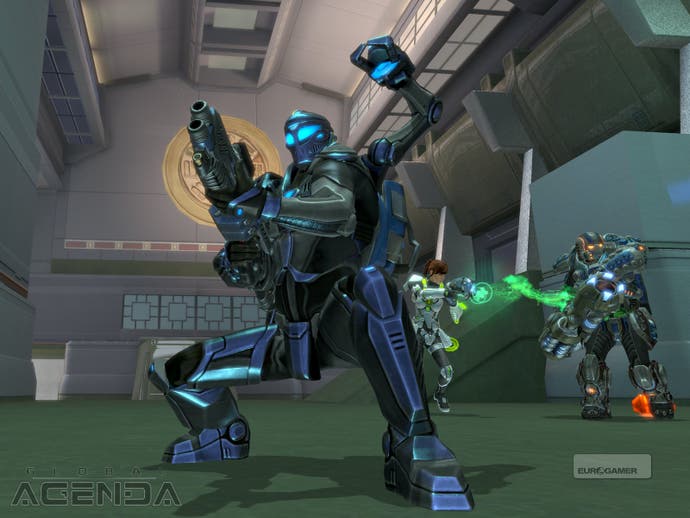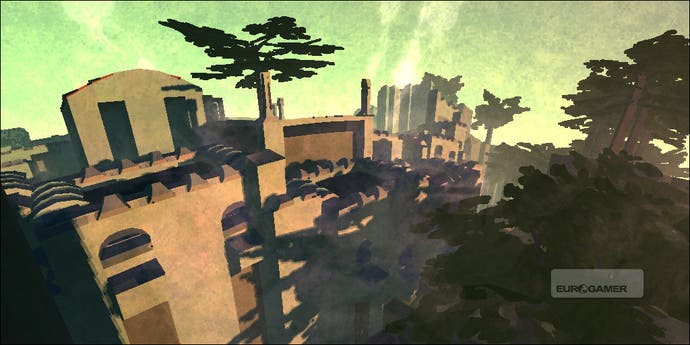MMOs' wild frontier
Think it takes a publishing sugar-daddy and big budget to make an MMO? Think again.
Global Agenda
And then along came Hi-Rez Studios' Global Agenda. Playable with the developers on closed alpha servers, this fast-paced blend of "spy-fi" MMO and deathmatch FPS stunned with its professionalism, slick graphical sheen and effortless playability. It puts many games from much larger companies to shame.
Funded by Erez Goren, an "eccentric self-made millionaire" in software who dreamed of being a games programmer in his youth, Global Agenda could be the ultimate vanity project in videogames - if something this focused, smart and appealing can be called a vanity project. A team of 45 based in Atlanta, many without a games background, has been piecing Global Agenda together since 2005.
The core of the game is in 15-minute player-versus-player matches that play into a massive global domination metagame contested by alliances of player-run agencies. This runs in "seasons" lasting around 45 days, after which a winning faction is declared. There's also one big NPC faction to fight: sinister despots the Commonwealth. The matches might involve escort missions or agency raids, but always result in fast and fluid skirmishes between the game's recon (sniping and intelligence), medic, assault, and robotics (remote control pets and turrets) classes.

Once again, the quality and specialisation of your gear is your primary concern, with Global Agenda's levelling system advancing versatility rather than power - appropriately for a game whose combat rests so heavily on player skill. Equipment is divided between primary and secondary ranged or melee weapons, jetpacks, and offhand gadgets with cooldowns that act more like your traditional MMO abilities, all fed from the same power source. In an RPG nod, damage comes in four kinds with matching resistances - energy, fire, physical and poison.
Equipping, re-equipping and re-speccing your character for action on a neat loadout screen is half the fun in Global Agenda. The other half is in battles which somehow maintain a furious pace without ever descending into chaos, in part thanks to a busy, colour-coded interface that makes all the damage and healing going on crystal-clear. Unlike so many MMOs, it's a tactile and physically satisfying game to play, too, with the weapons and jetpacks having a finely-tuned feel. The hi-tech future setting is entirely generic, but presented with a bold sheen and clear silhouettes for the chunky and appealing characters.
Global Agenda is very tight indeed, and for once the aimed-for June beta and end-of-year release seem entirely feasible. Score one for the poor little rich guy.
Love
As nice as Global Agenda looks, there's no doubt that the most visually arresting MMO I saw at GDC was made not by an eccentric millionaire's private army, but by an eccentric coder's army of one. Eskil Steenberg may well be mad, but one thing's for sure - he's outrageously talented.
We've covered his micro-MMO, Love, before. Check out Jim's preview from last year's GDC for the full details of this esoteric, atmospheric blend of city-building, FPS action, procedurally-generated worlds and breathtaking watercolour visuals. I confess I spent much of my time with Steenberg talking about his astonishing tools, a series of art and asset management programs with crisp vector graphic interfaces straight out of Rez that allow him to tweak assets on his servers in real-time.
You can debate whether Love - which will have a couple of hundred players to each server - is really a massively multiplayer game. You can wonder whether its fast-and-loose combat and collaborative progress will gel and compel, whether giving players the freedom to deform the terrain is a step too far, whether its tiny world will feel hemmed-in after a while.

The tactics and puzzle-solving based around disrupting energy lines and power grids to bypass shields - which have an environmental angle too, as wind-turbines die down around sunset in Love's short day-night cycle - are intriguing, and Steenberg says he'll concentrate on enemy AI in the next phase of development. But you can't, at present, tell whether Love will hang together.
You can, however, tell that people will want to play it. Its delicate, impressionistic visuals and lone-wolf indie cred will get it that far. Steenberg's plan to start with one server and grow the game organically may well prove impractical given the level of interest; he will, eventually, need help.
But his story is still an inspiring one. So is Hi-Rez Studios', which may operate at the other end of the financial scale but which is still an outsider in a way, just as EVE Online's developer CCP once was. Even in a post-WOW world, massively multiplayer games can be made outside the system and can still be beautiful, exciting, ambitious - and can work.








.jpg?width=291&height=164&fit=crop&quality=80&format=jpg&auto=webp)